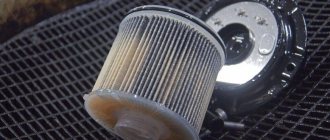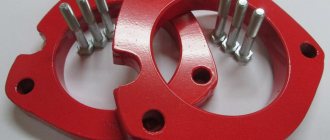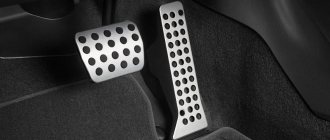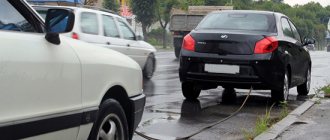If the engine of a car does not start, a modern person usually grabs his cell phone. But while waiting for help, it’s not a sin to think a little about the reason for what happened. It is possible that you can solve the problem on the spot yourself.
...In the cold, rattling keys is always more pleasant
Mikhail Zhvanetsky
A modern car, as a rule, starts instantly - it does not need to be tormented by long “cranks”. But even such cars sometimes fail, especially in the cold: they won’t start - and that’s all. Not all reasons for winter “non-starts” are related specifically to frost. It often happens that in the cold, some hidden faults are simply in a hurry to manifest themselves. Just in case, we’ll try to list the most popular causes of engine vagaries, but let’s start with purely winter troubles. We’ll put aside horror stories like “the motor is jammed” or “the teeth of the flywheel are chipped” for later: this is a topic for another discussion.
Reasons why a car won't start in cold weather
An important reason why a car does not start in cold weather is the condition of the battery. It is she who in 80% of cases becomes the “culprit” of an unpleasant situation. Low temperatures quickly “eat up” energy. This is especially true for old batteries, but new ones are not immune to problems. Several signs will help you make sure that it was the battery that failed you in the cold. If the battery is completely discharged, the numbers on the dashboard will not light up when you turn the key. The absence of any sounds will also indicate a discharged battery. Howling sounds will indicate that the charge is insufficient to start, but the starter will not turn over.
The second common reason when the engine does not start well in cold weather is out-of-season oil. It may thicken completely. You can check it with a dipstick: the thick composition will not flow, but stretch. Starting the engine in this condition is extremely dangerous for the car. Running the engine dry will result in a major overhaul.
Other causes of engine failure in cold weather
There are other reasons for failure to start the engine. One of them is that no gasoline or very little of it enters the combustion chamber. This happens in the following cases:
- low-quality gasoline;
- dirty injectors;
- clogged fine or coarse filters;
- malfunction of the fuel pump;
- not working RTD (fuel pressure regulator);
- starting temperatures below -30ºС;
- candles that have exhausted their service life;
- unsatisfactory condition of ignition coils;
- cracks in high-voltage wires leading to current leakage;
- poor condition of the engine CPG (low compression).
This is interesting: How to remove the steering tip on a Nexia
Why does the engine refuse to start in cold weather?
Most of the inhabitants of our country live in regions with harsh climates and even extreme winter conditions. This period of time turns into a serious test for all citizens without exception, including motorists, for the majority of whom failure to start the engine in cold weather becomes a real headache. Moreover, the most unpleasant thing is that even owners of new cars are not insured against this. What are the reasons for such failure and how can this be dealt with? Dear readers, today our online publication offers you detailed instructions on this issue, which you can personally read.
As you know, cold weather (especially severe frost) has a serious negative impact on any car. A vehicle is a complex technical device that requires the coordinated operation of many of its systems to run.
And sometimes it can be very difficult to figure out which of these systems led to the failure to start the engine, but nevertheless, friends, it is possible.
See also: 27 questions from motorists about the cold
So, what components of the car are primarily affected by frost? The most common causes of engine failure are the following problems: - with the battery, with the fuel system, with the starter, with the generator and with the engine oil. Let's look at each problem in more detail and separately.
Electrical fault
Most of the vehicle electrical equipment failures occur in winter. Main reasons:
- electrolysis processes;
- increased currents in power supply circuits;
- increased corrosion at high humidity.
Electrolysis inflicts the greatest blow on a car's electrical wiring in winter. How it happens. As a result of strong temperature changes in the engine compartment, the polyvinyl chloride insulation of the conductors begins to crack. Salty moisture penetrates into microcracks (the result of road treatment). Between the car body, connected to the negative bus of the battery, and the positive potentials of the current-carrying conductors, which are exposed to the salty electrolyte, the process of electrolysis begins to operate.
Positive copper ions rush towards the negative body in a friendly stream. As a result of this, the fatal destruction of the conductor occurs: it turns into green dust. First, this leads to malfunctions in the operation of electrical equipment, then to the complete failure of individual components and engine shutdown. Preventive measures: timely removal of contaminants;
- application of special protective coatings;
- engine protection.
Non-conductive silicone grease in spray form works well as a protective coating. It can be applied to conductors, contacts, harnesses.
The most dangerous from the point of view of failure to start the engine is corrosion at the point where the negative bus from the battery is connected to the car body and to the engine. Before the start of the season, you should definitely check the quality of these compounds.
In gasoline engines, it is necessary to evaluate the integrity of high-voltage wires and the absence of breakdowns. This can be done visually, attempting to start it in the dark. A spark will be observed at the breakdown site. The faulty wire must be replaced, preferably as a whole set.
Reasons for difficulty starting a car in cold weather
Novice drivers are interested in the question of why the car does not start in cold weather. There are plenty of reasons: problems with the battery and starter, an increase in lubricant thickness, disruption of the fuel supply in the system, as well as the use of summer grades of diesel fuel in diesel cars.
Battery problems
The battery is the main culprit for problems with starting a car in cold weather, especially if the battery has been actively used for more than 3 years - at this time its power begins to decrease. In addition, particles of rust and dirt accumulate on the battery terminals over time, and oxidation of the terminals and contacts can be caused by temperature fluctuations: when the motor is turned off, the wires have the same temperature as the environment, and at the moment of starting they begin to heat up. This process leads to a gradual breakdown of the integrity of the connections.
Chemical processes inside the battery slow down at sub-zero temperatures: already at -15...-20°C it operates at only 40% of its potential even when fully charged - this is another reason for problems with starting the engine.
Starter malfunction
It is not uncommon for the starter to break down in winter. This unit is subject to critical loads in cold weather due to:
- thickening of lubricants;
- freezing of moving parts of parts due to condensate freezing on them;
- changes in resistance at the contacts.
All this leads to an increase in the current flowing through the armature, which causes incorrect operation of the unit, and sometimes even destruction of the armature, starter brushes, and commutator lamellas.
Thickened motor oil
At subzero temperatures, lubricants tend to become thicker, which increases resistance in rotating and moving mechanisms. This, in turn, increases the load at the starting moment on the battery, which is also cooled, as a result of which the battery discharges faster. Using special winter brands of oil can partially solve the problem.
The coolant also works only in the temperature range specified by the manufacturer; when this indicator decreases, it freezes. At the same time, the starter will continue to rotate, which often causes breakdown of the entire unit and makes it impossible to operate the car. To avoid this, use coolant designed for the appropriate climate conditions.
Bad gasoline or its supply is interrupted
The use of low-quality fuel also becomes a problem. The drops of moisture contained in it, freezing, form ice plugs that prevent the normal flow of the mixture into the combustion chamber. You can prevent trouble by using high-quality fuel or specialized additives.
In cold weather, the operating parameters of fuel pumps deteriorate, which leads to problems in the functioning of injectors and nozzles. Misfire may occur in some or even all cylinders.
The ignition system is misregulated
The main “winter” enemy of the fuel system, which causes its imbalance, is moisture entering the unit in the form of condensate. It freezes at sub-zero ambient temperatures, preventing the flow of the fuel-air mixture.
Spark plugs flooded
In winter, it is necessary to use proven spark plugs; it would be a good idea to change them in the off-season, before the first cold weather begins, and also have a spare set of spark plugs with you. In addition to the general problems that can arise at any time of the year, there is also a typical “winter” problem - the candles are flooded with fuel.
In the cold, the formation of a combustible mixture requires a change in conditions. In frosty air, the concentration of oxygen is increased, and accordingly, more gasoline will be needed, and the command to increase the fuel supply is sent by the electronic control unit to the injector nozzles. A cold starter produces a weak spark, and meanwhile the injectors continue to supply fuel to the system, which fills the spark plugs.
The use of summer diesel fuel in diesel cars
A diesel car may not start in winter due to the use of the wrong fuel. Summer diesel fuel - a special type of diesel fuel - can only be used at an ambient temperature of at least -5°C, because already at -6°C it becomes cloudy and thick, and at -7... -8°C it begins to solidify.
The crystals formed in this process:
- the fuel filter is clogged;
- accumulate in the heat pipe;
- damage the engine and other components of the mechanism.
If it is not possible to use winter fuel, you should definitely use special additives for diesel fuel.
How to protect yourself
There are several general recommendations that will help solve the problem when the car does not start in the cold. The choice depends on the situation and engine type. Some tips are preventive in nature, even if there are no issues with the launch, it is better to protect yourself:
- Buy a set of wires to start from another car. It doesn't take up much space, but it will help a lot if the battery is low. The second option is a starter charger; it simply starts the car, which is very convenient. This option is required for machine guns, since they cannot be carried.
- Have a cable handy. Suitable for manual transmissions only. The simplest solution if the engine has trouble starting in cold weather.
- Monitor the condition of the battery. If you have questions, it is better to disconnect it at night and bring it into the house. A warm battery works much better. If you live in a cold region, then it makes sense to buy a gel battery; its characteristics hardly change as the temperature drops.
- Install a heating system for fuel lines. There are separate kits that warm up the fuel line and filter; they are perfect for diesel engines. Gasoline cars do not need this, since the fuel does not thicken at subzero temperatures.
- Change oil before winter. Choose an option with lower viscosity. Synthetics are best suited, as they thicken much less than mineral options.
Advice!
Cars with an automatic transmission must warm up after starting. If you drive straight away, you can damage the transmission.
Before winter, you should diagnose the machine, identify all faults and eliminate them, since in cold weather they manifest themselves especially strongly. If a problem does arise and the car does not start even with the wires, then the easiest way is to pull it into a warm garage and let it warm up for at least an hour.
Other reasons
There can be many reasons, and the consequences can be different.
If, after checking all the units described above, you have not found out the cause of the malfunction, then professional diagnostics are required, that is, you need to contact a service station.
What to do in the cold?
What else you can read:
- Pagani Zonda R – Limited Edition
- Kia Optima 2021 will receive body restyling
- DFM AX7 – Crossover certified for the Russian Federation
- Honda Accord 2015 – Test drive video, specifications and reviews
- What to do if the culprit of the accident fled the scene?
- Audi Q7 2015 – Prices and specifications
- Porsche Macan – photos and videos from the test drive
- 2021 Chevrolet Trailblazer – American Loses Its Roots
Purely winter reasons
- The fuel decided to act up: something liquid froze. This could be drops of water in the gas line, or summer diesel fuel sold to you under the guise of winter (in the fuel tank, in the filter - it doesn’t matter). The real method of treatment is evacuation to a warm room. No antigels or other auto chemicals will help - these are just means of prevention, but not treatment.
- In the cold, the engine oil has thickened so much that the starter is unable to crank the crankshaft. The cure is obvious: see previous point. It was necessary to fill the oil on time for the season, but now you need to somehow get to a warm garage, and then drain the 10W oil (or whatever you had there?) and fill it with 0W (or at least 5W). Or wait for the thaw if you are not in a hurry...
- The glow plugs in a diesel car are faulty. It is clear that in winter this occurs more often than in warm weather: many people deliberately heat the spark plugs in several stages before giving the starter the “Start” command. In short, you need to change them without hesitation, and all at once - it won’t get any worse.
- The starter turns incredibly slowly. If the oil is seasonal, then most likely the culprit is the battery, which has become weak from the hard winter life. Recharge, replace, light a cigarette from a good neighbor's car, use the starter - decide according to the situation and the actual condition of the battery. By the way, have you ever thought that the price of a new battery today is almost comparable to the cost of a couple of gas stations? In some cases, such a purchase is quite justified.
- The exhaust pipe is clogged. This could be caused by a purely winter reason: driving backwards into a snowdrift, for example. It is clear that the pipe, like the exhaust, needs to be “given freedom”.
In some cases, a tow truck is a lifesaver.
For example, if the fuel is frozen in a diesel car, then the best way out is to drive with someone’s help to a warm room. In some cases, a tow truck is a lifesaver. For example, if the fuel is frozen in a diesel car, then the best way out is to drive with someone’s help to a warm room.
How to start correctly in cold weather?
Here's how to start your car in cold weather:
- Press the gas pedal several times to ensure the supply of fuel to the cylinders;
- you cannot turn on the stove, headlights and other energy consumers;
- set the gearshift lever to the neutral position, press the clutch;
- try to start the engine in short (about 3-5 seconds) sessions with 30-second breaks;
- After a successful attempt, you should warm up the car for about 15-20 seconds, and then smoothly release the clutch pedal.
The algorithm of actions for cars with automatic transmission is the same, only you won’t have to press the clutch pedal due to its absence.
Preventive maintenance will help you not to worry that you won’t be able to start your car after frost. It consists of changing the oil to winter oil, replacing the oil, air and fuel filters. It would be useful to check the density and level of electrolyte in the battery, the condition of the spark plugs and the generator before the onset of cold weather.
Basic ways to start a car in cold weather
Before starting the car, turn off all energy consumers - headlights, heated seats, mirrors and windows. Do not allow the starter to spin for too long, as this may cause it to fail. Make several starting attempts, with a pause between which should be at least 1 minute, - this way you will reduce the load on the battery, and in cars with manual transmission, press the clutch when trying to start the engine.
There are several ways to start a car in cold weather, let's look at them in more detail.
Move the battery to a warm place
The performance of even a fully charged battery in severe frost is reduced, which makes problems with a dead battery more likely. Therefore, it would be useful to use the old-fashioned method - remove the battery from a stationary car and store it in a room with a positive temperature. You can also warm up an already frozen battery, but this may take up to 3 hours.
Under no circumstances should you forcefully heat the battery, much less place it near sources of open fire.
Recharge the battery from the charger
This method is suitable if the driver has at least half an hour to an hour. The procedure is carried out in the traditional way - the terminals are disconnected from the battery and the charger clamps are connected in their place.
Boost your car battery with headlights
This procedure involves turning on the high or low beam headlights for 15-20 seconds. Then they should be turned off and the key turned in the starter. In most cases, the engine starts, but if this does not happen, try again after a couple of minutes: turn on the headlights again and try to start the engine. If 3 attempts are unsuccessful, it means the battery is completely discharged.
Light a cigarette from another car
For this operation you need a second car, without problems starting the engine. The positive terminal of the problem battery should be connected with a wire with an alligator clip to a similar terminal of the charged battery. With the second such wire, connect the negative of the battery with a normal charge and any metal element of the engine of your car. It is not recommended to connect the negative terminals to each other, except in cases where you do not have exposed areas under the hood, for example, they are covered with plastic.
First, the car starts with a charged battery and runs for about 20 minutes at 2000 rpm - this should be enough for the dead battery to charge to a level sufficient to start the engine on its own. Then the second car is started, and if the start is successful, both vehicles are left running for another 5-10 minutes. After this, you can disconnect the wires by first removing them from the battery of the donor car, and then from the recipient.
Try to push start the car
This method is only suitable for cars with a manual transmission and if the driver has an assistant, because at least two people need to perform the procedure: one will steer, the other will push. The operation is carried out in the following order:
- the clutch should be kept depressed;
- the driver turns the ignition key;
- The gearshift lever is immediately set to 2nd or 3rd speed;
- the assistant, pushing the car, accelerates it to approximately jogging speed;
- The clutch releases smoothly.
Immediately after this, the car should start, but do not set off immediately - let the engine warm up for at least 10 minutes.
Start the car using special equipment
If all previous methods of starting a car in severe frost have not been successful, you will have to contact a car service specialist. They use special portable charging devices. Their use is the simplest, most effective and at the same time safest way to start the engine.
Buy a new battery
But if even an experienced technician using specialized equipment could not start the car, you will have to buy a new battery. In this case, a model should be chosen with greater power than the previous battery. All new batteries are supplied charged and therefore ready for immediate use.
This is interesting: How to properly light a cigarette from a car










